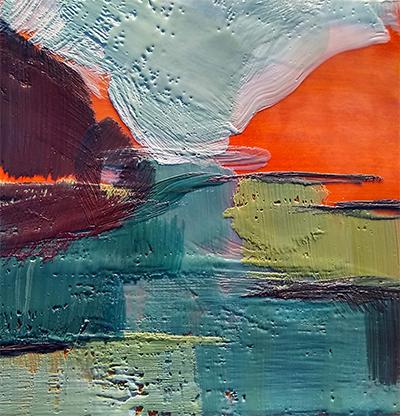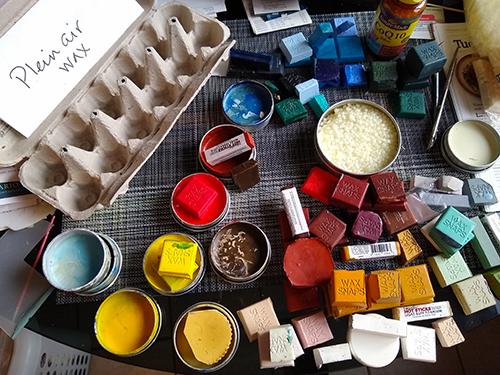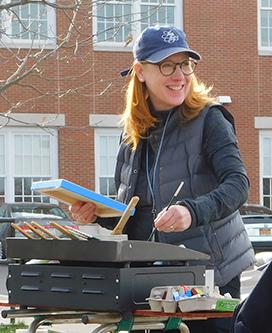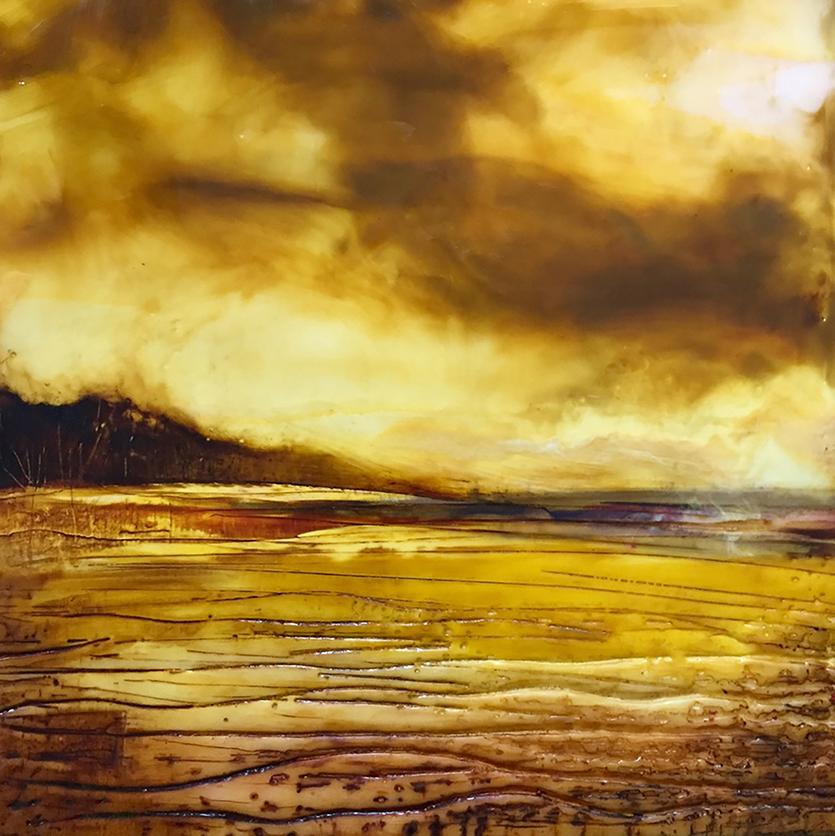
11 minute read
Wax Unplugged
Wax Unplugged Plein Air Encaustic Painting
Phyllis Bryce Ely
My paintings are rooted in landscape, inspired by dramatic skies, moving water, coastal edges, and churning nature. My intention is to give viewers just enough form and color to evoke a feeling of connection, inviting them to bring their imaginations to my experience of a place. I live and paint along the Lake Ontario shoreline near Rochester, NY, a region that owes its beauty to glacial scouring that left behind rolling terrain and abundant fresh waterways, including the Finger Lakes.
I am a studio and plein air painter —the two are halves of one whole that influence each other and give me balance. Working directly outdoors connects me with nature as I explore the idea of place.
In the studio, I work in oils and encaustic wax. Oils are my baseline joy, but hot wax has become my most adventurous medium with inspiration coming from the molten wax itself. The ability to paint, build, carve, collage, print, and combine with other media is compelling.
Plein air challenges me with its demand for complete attention and immediate response. Each painting is evidence of an experience of a connection and, like a journal, each speaks to the day it was painted. For decades, painting outdoors using traditional media was enough for me —that is, until I crossed paths with encaustic wax about nine years ago.

Ontario View Encaustic 6 x 6 in

Plein Air Basics
Regardless of medium, plein air fundamentals are universal. A satisfying experience is dependent on planning and preparation to preserve working time. Quick advice: plan your destination and schedule according to lighting and weather; anticipate your color palette and organize paints accordingly; prepare a variety of substrate choices; use short-handle brushes; pack your gear in a portable cart and re-stock after an outing so you're ready for the next time; and dress for conditions so you are not distracted by yourself.
For your comfort and safety, know where restrooms and services are located, bring a phone, tell someone where you’re going, and paint with a buddy if you can.
When painting, commit to what inspired you; it’s tempting to chase changing conditions.
Work efciently: mass major shapes, build value structure, add detail until you feel finished. The goal is to complete a painting in one session without further work. Despite all your planning you are subject to nature and circumstances, so be open to surprises —some of my favorite plein air paintings are the ones I didn’t expect to do!
Casey Park, October Encaustic 6 x 6 in


Getting Unplugged: IEA Project Grant
Although oils are a plein air staple, encaustic wax and its need for electricity-fed heat kept me tethered to the studio. I wanted to bust outside to connect plein air with encaustic wax. How could I overcome “the plug”?
The obvious starting point was a camp stove. I began fiddling with scenarios and pestered my engineer husband with technical questions. What kind of stove would work and be portable? How could I manage heat? What’s better, butane or propane? The best answer was to experiment, and he gave me a small one-burner Coleman camp stove to get started.
About then, I learned about the IEA Project Grant and decided to apply to pursue an “unplugged” encaustic workstation. In 2019, my proposal was accepted, and I got to work over the next three seasons in a variety of conditions and locations.

Photos of Phyllis painting by Mark Ely
Experimenting with Camp Stoves
I began by experimenting with the Coleman using what I had on hand: an old cast iron griddle, an anodized aluminum monotype plate, a grill thermometer, and butane fuel. My first lesson learned was that because camp stoves are designed for high heat, it was a challenge to keep the surface temp low enough for wax. I tried a few configurations to chase the temp down, including diferent types of metal sheets and even a soapstone slab. Wind threatened the stove’s flame, so I propped up a foldable stainless steel pizza peel as a windbreak. Torch fusing went as expected but the flame is not visible outdoors. I relied on my own shadow, sound, and reaction of the wax to manage the flame. I soon learned that melting wax on an uneven surface runs to the low side in a puddle. My substrates were Ampersand panels with Pan Pastel underpainting and wax medium.
www.amazon.com/Coleman-Portable-Butane-Stove-Carrying/dp/B00FGPXVSM/ ref=sr_1_23?dchild=1&keywords=coleman+stove&qid=1610830056&s=sportinggoods&sr=1-23

After the Coleman, I wanted a more substantial and roomy workstation and chose the Blackstone table top portable 17” grill for its size, surface, and weight. I practiced in my own yard and came to like this stove. Its raised edges ofer wind protection and provide a brush rest to keep tips in contact with the warm surface. I added the same 10” x 14” anodized aluminium plate on top of that as my palette. Again, keeping the temp low enough for wax was a challenge. The plate ran too hot, and I needed a spacer to lift the plate from the griddle. I tried coins, jar lids, baking parchment, and thick button magnets—anything to interrupt the heat flow. Coins and jar lids were okay but scooted around; parchment worked well and made it easy to lift the plate. The magnets worked the best and stayed in place. In fact, magnets turned out to be helpful all around. I now use them along the sides to keep brushes in place and a tiny magnetized bubble level helps me set up a flat work surface. Shop grill accessories for other ideas and tools.

www.amazon.com/gp/product/B0195MZHBK/ ref=ppx_yo_dt_b_search_asin_title?ie=UTF8&psc=1x
Brand Heat source Fuel/temps Fuel duration Set up Working area Work surface Wgt Est cost
Coleman single burner
Blackstone H-burner with cook surface Butane canister, unreliable below 32℉ about an hour tabletop your metal plate
Propane 1 lb., good to -40℉ a few hours tabletop or butler stand cook surface 15 ¼” x 17” anodized aluminum plate anodized aluminum plate 4.7 lbs $45
21 lbs $115
Working and Learning
With a workstation sorted out, I set out to paint. I organized my paints into palette-themed egg cartons and prepared a pile of small Ampersand panels with a variety of underpaintings and wax medium to suit just about every scenario.
I packed a rolling cart with supplies, tools, papers, and ventured to favorite local painting spots including Lake Ontario and the Erie Canal.
I recommend making a supply checklist.


Wax Unplugged Checklist
Workstation
❏ campstove ❏ sturdy table or butler stand for campstove ❏ long sturdy board for extra work area if using a stand ❏ fuel and spare ❏ sharpie to mark start and stop times on fuel container ❏ anodized aluminum plate ❏ spacer of choice to elevate plate above hotplate (magents, expanded aluminum grill, parchment, pennies…) ❏ temperature gauge ❏ small magnets for brush holders on edge of stove ❏ wind break (I use folding metal pizza peel) ❏ stand or table (heat tolerant) ❏ long board that extends beyond camp stove for working surface ❏ small magnetic level ❏ shims ❏ torch, fuel, spare
Substrates
❏ prepared boards with variety of underpaintings and wax medium (if you know your composition, lay in underpainting of your choice in advance) ❏ small Arches 88 and rice papers for “clean up” monotypes
Painting
❏ paints organized for quick access, no hunting (egg cartons) ❏ lots of wax medium (pellets best) ❏ brushes ❏ surface/incising tools ❏ PVC rounds to elevate boards while working and fusing (multiple)
Other
❏ wheeled pull-cart/crate with top for storage, transport, and table surface ❏ potholders ❏ small tongs ❏ paper towels ❏ apron ❏ folding side table (TV tray) ❏ clean pizza boxes to store paintings ❏ wax paper if you need to stack work
Safety and comfort
❏ tell someone where you are, paint with a friend ❏ charged mobile phone/camera ❏ if cold, scrap of carpet to stand on ❏ bug repellent (they like colors and smell of beeswax) ❏ water and snacks ❏ water/fire extinguisher just in case
Compared to traditional plein air painting, encaustic wax has some unique factors. To begin, there's even more emphasis on preparation and set up. Because of ongoing heat management, my attention was split between fussing with the grill and painting.
Choosing a place to set up is trickier too because the need for a level surface is more restrictive than popping up a tripod easel. Time spent to prepare paint is about equal, melting tins of medium and paint runs about 10-15 minutes (loose foil over the stove helps speed this up).
To track fuel, use a Sharpie to log the date and duration of use on each canister, and always pack a few spares of butane/ propane to avoid running out.


While the paint is coming up to temperature, warm brushes and keep them in contact with the plate or they will stifen quickly in the open air.
Get your substrates in place and set up a fusing station in a spot free from wind and with shade or dark background so you have a better chance of seeing the flame.
And when painting, keep a constant eye on the surface thermometer to prevent the paint from cooking. If it runs too hot, adjust spacers and continue to monitor.
Over the past year, I have gained better control over managing the technical bits and now most of my attention has shifted to painting.
Painting Experience
I’m accustomed to the feel and logic of wet-on-wet oils outdoors. I also have a feel for molten wax indoors. In contrast, my hot wax brushwork had a hit-and-stick feel in the open air, particularly in cool weather or breeze when the wax and brushes seized up quickly. (In the summer heat everything was more fluid.) I found myself using more medium than usual and learned to keep brushes in direct contact with the plate to keep them workable. Hake brushes seem to hold heat best. I relied on building thin layers and making adjacent marks to develop my paintings, much like working with soft pastels. This surprised me, but when I went into my “pastel brain” habits, I made progress.

Plein air wax has its advantages! It’s always good to have a snack on hand when painting outside, with a camp stove you can enjoy a hot snack or drink.
Cleanup is more creative too with small sheets of rice paper on hand to make monotypes with unused wax to use later for collages. When packing up, paintings are dry and easy to manage.

On the dark side, outdoor painting attracts insects that like to dive into paint, especially warm colors. Sometimes they drag themselves out, but it’s not so easy with wax. And sadly, the hot griddle is not so kind to curious insects. If they happen to land in your painting you can remove them immediately or sort it out later. Wax is forgiving.
Plein air painting is an inspiring and humbling practice that connects artists to nature. I find it is always worth the efort to head outdoors to see what happens.
My grand plans for a spring road trip were foiled by the coronavirus pandemic, and I’m still looking forward to an iconic sunny winter day with long blue shadows. I am eager to continue my plein air adventure with wax to see where it leads and how it will afect my studio work.
I thank my studio mates and fellow IEA members, Maureen Church and Anne McCune, and the Genesee Valley Plein Air Painters, for painting with me and ofering feedback. I especially thank IEA for the opportunity to pursue this project and welcome contact from anyone who would like to know more.
About the Author Phyllis Bryce Ely earned her BFA in painting and printmaking from the Rochester Institute of Technology in 1981. She paints en plein air and in the studio and is regarded for her landscapes and depictions of upstate New York, Lake Ontario, the Finger Lakes region, and her travels. She paints primarily in oil, encaustic wax, and oil with cold wax medium.
You can view Phyllis’ work at www.phyllisbryceely.com www.facebook.com/phyllis.ely www.instagram.com/pbryceely

Erie Canal Pittsford Encaustic 10 x 8 in










